Vungle (now Liftoff): Creative Manager & Playable Upload
VUNGLE WAS A B2B AD NETWORK PLATFORM THAT ENABLED APP DEVELOPERS TO MONETIZE AND GROW THEIR USER BASE VIA AD DISPLAY IN MOBILE APPLICATIONS (GAMING & BRAND)
Vungle was a mobile ad platform helping app developers promote their apps through in-app ads. It enabled developers to earn from their apps by adding video ads that showed up while users used other apps, designed to be engaging and unobtrusive, sometimes with user rewards. Vungle's platform let advertisers create, manage, and track video ad campaigns, reaching specific audiences based on criteria. Their goal was quality user-oriented ads, enhancing experience and revenue for developers and advertisers.
Main Objectives & Outcomes
During my tenure at Vungle, a prominent focus was on enhancing client experiences and streamlining processes. One significant achievement was the introduction of a feature allowing clients to independently integrate their custom Ad Units into the Vungle network. This innovation, highly requested by clients, brought about several noteworthy outcomes:
Client Autonomy and Revenue Boost:
Facilitated client integration of tailored Ad Units within Vungle.
Addressed high demand for autonomous ad campaigns, positively impacting client satisfaction.
Encompassed web, mobile components, and an Administrative tool.
Supported Playable Ads and non-video fullscreen ads, unlocking diverse ad revenue sources.
Automated Ad Validation and Efficiency:
Reshaped ad review with automated validation, dramatically slashing review duration.
On the technical side:
We set the foundation for training a model for full automation over time.
Database of recorded Playable ad unit videos that GameRefinery then attributed their taxonomy so later our team could distinguish between high-performing ad units.
Shifted validation responsibility to clients, reducing Sales involvement.
Streamlined validation benefits approximately 100+ clients, fueling revenue growth.
Resource Efficiency and New Business:
Liberated Sales from manual processes, enabling focus on growth.
Reallocated QA resources to strategic endeavors, amplifying productivity.
Expedited custom Ad Units integration, converting potential losses into deals.
Attracted new business opportunities due to expanded capabilities.
In LATE 2020, amid iOS-side IDFA loss, we aimed to reposition Vungle beyond video ads and enable Customers to upload custom Playable Ad units
As privacy concerns emerged on the Apple iOS platform, the advertising industry underwent a transition, pivoting away from heavy reliance on user attribute targeting toward a greater emphasis on contextual targeting through Creative Ads. Concurrently, on the commercial front, a move was made to introduce non-video fullscreen ads across our network. Responding to market demands, we also initiated the incorporation of custom Playable Ad Units, which had proven to be highly effective (constituting 90% of high-performing ads), accommodating customer preferences similar to their experiences with other networks.
Overview of Creative: its Significance and Influence on Vungle
-
• Develop features that allow clients to independently integrate their custom Ad Units into the Vungle network.
• Expand the scope of autonomy to encompass web and mobile components, as well as an Administrative tool.
• Ensure compatibility with diverse ad formats, such as Playable Ads and non-video fullscreen ads, to unlock multiple revenue sources.
• Continuously gather client feedback to refine the integration process and address evolving needs, ultimately boosting client satisfaction.
-
• Further automate the ad validation process to significantly reduce review duration.
• Empower clients with greater responsibility for ad validation, reducing Sales team involvement.
• Identify opportunities to streamline validation for an expanding client base, thereby contributing to revenue growth.
• Investigate ways to automate and optimize other operational processes to enhance overall efficiency and resource allocation.
-
• Reevaluate Vungle's ad strategy in response to the evolving iOS landscape and the shift towards contextual targeting.
• Implement support for non-video fullscreen ads across the network to cater to changing industry trends.
• Enhance the capabilities of the client-facing product by introducing functionality for Playable and image asset uploads.
• Develop high-performing templates within the Advertiser Self-Serve product, aligning with market demand for customizable ad content.
the process & personas
In collaboration with the Advertiser UI Product Manager, we embarked on identifying critical stakeholders beyond the Product and Engineering domains. This encompassed Vungle Account Managers, Client: User Acquisition Managers, and Internal Operational teams. Our research strategy involved a series of interviews and surveys aimed at discerning insights about non-fullscreen and playable ad units. These research endeavors were conducted via Hangouts and led by both myself and the then-current Product Manager.
-
Internal employees who maintained client relationships on the Ads Manager side of the business.
-
Brands such as Rovio with Angry Birds.
-
An offshore content management and review team responsible for evaluating content and quality of ads.
summarized insights
Conversations revealed that the Sales team managed client requests containing assets (images, videos, playables) and instructions for a specific app and ad campaigns.
Subsequently, Sales created Salesforce tickets for the operational team, who uploaded assets using our internal Admin tool.
Playable Units underwent a more complex internal review process due to their intricate structure.
Our client-facing product lacked the functionality for Playable and image asset uploads.
Templates within the Advertiser Self-Serve product did not include high-performing options for selection.
Competitor Review & SAAS Impact
The research findings underscored that competitors within the same industry featured Playable Ads accessible via their Self-Serve UI. Concurrently, various SAAS tools available in the market offered Playable Builders, empowering clients to promptly craft Ads utilizing pre-designed templates. Consequently, clients could efficiently integrate and evaluate Playable Ads across different networks by leveraging these template builders in their ad campaigns.
By merging findings from stakeholder interviews, competitor insights, and goal alignment, I spearheaded initiatives to formulate the Optimal User Scenarios & Analysis of Current Workflows.
As a Client user utilizing the Advertiser Self-Serve UI, my objective is to upload fresh videos, images, and playable units to craft compelling creatives using more effective templates.
Subsequently, the newly uploaded playable units from Clients would undergo thorough quality assurance by the Internal Operational Team through our backend Admin tool, aligning with Vungle's Playable Ads standards and SDK.
Upon approval, these novel units can then be harnessed to generate innovative creatives.
Former Creative Editor. Support was limited to video creative templates, unlike Playable Creative templates.
identifying requirements, Technical Constraints & Dependencies
In collaboration with the Advertiser UI Product Manager, we pinpointed a set of prerequisites that required fulfillment:
Revamp the current Creative Manager to enable the upload of multiple assets.
Adjust the UI to closely resemble those in the competitor market based on the feedback we received.
Collaborate with the newly formed "Creative Experience" team to integrate the manual Playable QA process with the existing UI.
Recognizing the expanding scope of the project beyond its original goal, we strategically chose to bifurcate the overall end-product into two separate tracks, each entrusted to a dedicated team. This decision was central to our adoption of a multi-track approach, considering the project's increasing complexity and scale.
Team A: Creative Manager Updates
Enhance the current Advertiser UI to accommodate a greater variety of Ad units. Implement the Playable Ad unit template, facilitating asset reuse for users.
Team B: Playable Upload Support & Review
Develop a review process for Playable Assets.
Ultimately, integrate the two functionalities and merge their respective pipelines.
Team A: Creative Manager Updates
EARLY CONCEPTS, FEEDBACK CYCLES & USABILITY TESTING
With a foundational set of requirements and user flow in place, along with a solid plan, I began iterating on potential designs and functionalities for the product. These concepts aimed to replace the outdated Creative Manager feature and underwent iterative feedback loops with stakeholders. The overarching idea involved facilitating bulk asset uploads (including images, videos, and .zip files) for users, mirroring the approach of the original production creative editor. Following this, users would be able to select templates, enabling us to swiftly generate creatives with flexibility.
Outcomes and Feedback from UI/UX Usability Testing:
Engaged stakeholders in iterative feedback cycles, demonstrating Sketch iterations and Maze data for design refinement.
Conducted surveys across internal users, clients, marketing, and engineering to gather varied perspectives.
Collaborated with marketing and technical writers for clear communication of the end product by adjusting thumbnail sizes and restructuring template categorization.
Recognized and addressed issues with the "Asset First" approach in the current product, leading to concerns and complications with template unlocking.
Used FullStory to identify time to creative creation in the current product was an average of 3 minutes.
Streamlined the workflow to eliminate the problematic experience of adding a nested workflow, which had proven confusing for users during the creative process.
Implemented a bulk asset upload feature to ensure scalability for future use.
Prioritized enabling a consistent preview feature, diverging from the live product. Collaborated with engineers to seamlessly integrate the previewer into the UI, drawing inspiration from industry leaders like META, Google Ads, and Snapchat.
Through this collaborative process, the design naturally evolved, leading to a polished and user-centered solution. The depicted core concept ultimately became the direction we pursued.
Collaboration and Minor Requirement Changes
While engaging with other team members, it became apparent that there was a lack of technical capacity to incorporate batch-creation options and recommendations.
Consequently, these more advanced features were postponed for future consideration.
It's worth highlighting that the Product Requirements and Technical Requirements were developed in parallel.
Design handoff was completed via Sketch + Abstract App
Feature Flag Implementation & Controlled Access:
Employed feature flags for the Playable template option, restricting access exclusively to managed clients.
Strategically controlled product release to ensure access for managed clients and facilitate iterative testing over time.
End-User Limitations for Playable Ad Units:
Constrained end-users to select from existing Playable Ad Units vs uploading new asset files as Team B would handle the Ad Validation project.
Restricted the capability to add new Playable Ad Units, ensuring controlled and managed growth of the feature.
User Interaction of the New Creative Editor
Key Outcomes
Leveraging FullStory Insights:
By utilizing FullStory, we observed a daily active user increase of approximately 100+ users for the Advertiser Self-Serve UI.
Notable growth was seen in both non-fullscreen Creatives and Playable Creatives across the network.
Establishing Creative Scaling via the UI:
This initiative laid the groundwork for expanding creative scalability through the user interface.
Enhancing Sales Efficiency and Satisfaction:
The efforts resulted in heightened satisfaction and improved efficiency within the Sales department where they would no longer need to Create Playable specific creatives moving forward.
Team B: Playable asset upload & validation
Just a reminder, while Team A worked on the Creative Manager Product, Team B was concurrently dedicated to crafting a UI for the manual Playable process. On a positive front, I contributed to both teams. However, on a less fortunate note, we encountered difficulties due to the departure of key team members during this phase. Consequently, I took on the role of a Product Manager to drive the project forward. Requirement PRD sample.
Research & Findings
In the initial research phase, we discovered an existing manual review process. Key points of this process include heavy reliance on email/Slack exchanges, JIRA tickets, and Salesforce requests. Additionally, Vungle Creative Labs had developed ad hoc internal tools. This process demanded the time and involvement of multiple stakeholders for content review. While functional, the process suffered from scalability limitations, and the typical timeframe for getting a custom Playable Ad unit live on the network was around 3-4 weeks.
Design + Product Management + Engineering Collaboration
Userflow Refinement
Collective Technology Integration:
As a collaborative effort, we leveraged our existing tech resources.
Our goal was to minimize the time and effort required to introduce a new Playable unit to the network.
Preserving Proprietary Technology:
Concurrently, we ensured the retention of our proprietary technology, specifically concerning a template wrapper.
Technical architecture of concurrent processes where we recorded the gameplay of the file to place them in repository for an acquired company (GameRefinery) to pick up and assign their taxonomy for our Creative team to then use to assess attributes of high performing Creatives in the network.
Streamlined Client Playable Asset Upload Process and Internal Operational Team QA & Ad Validation Review Workflow
Integration With Existing UI
As a team, our goal was to enhance and build upon existing UIs rather than create new pages. We had a foundation for Uploading a Playable unit already established. To streamline the process, we utilized the existing internal Admin tool to construct a condensed Review/Feedback cycle for uploaded Custom Playable units. However, obtaining feedback on design iterations posed challenges.
*Please see the overly simplified user flow illustration on the right.
CLIENT PLAYABLE ASSET Libray & UPLOAD
Within the Ads Manager Self-Serve UI, users would upload a Playable Asset either via the Creative editor or the Asset Library List. Subsequently, an automated validation process would assess the technical requirements of the file. If the file met the necessary criteria, it would advance to the Admin console for manual review by the Internal Operational Team members.
Automated review was not yet feasible for certain aspects, hence the need for manual evaluation. However, with this manual evaluation, we set the groundwork for training the model to eventually automate all the manual processes.
Asset Library Introduced on the Self-Serve product
Asset upload function
Admin CONSOLE
After the asset undergoes automated validation, the Internal Operational Team takes over by reviewing the queued file. Their manual assessment ensures the file's integrity and compatibility with the Vungle Ad Network, verifying that it can function correctly.
The asset would undergo the following tests and user flow:
A Visual QA cycle for users to verify the file's compatibility with the network and adherence to terms of service.
A Functional QA cycle was conducted on a mobile device.
We implemented a modal overlay UI/UX to ensure the accessibility of the product at any point.
Additionally, we incorporated an activity log for auditing and a sequence of email triggers to involve all relevant personas (including Vungle Account Managers, Client: User Acquisition Manager, and Internal Operational teams) throughout the workflow.
Occasionally, necessary edits were identified, prompting internal users to provide feedback. Clients then had the opportunity to make modifications and updates, replacing the original file as needed.
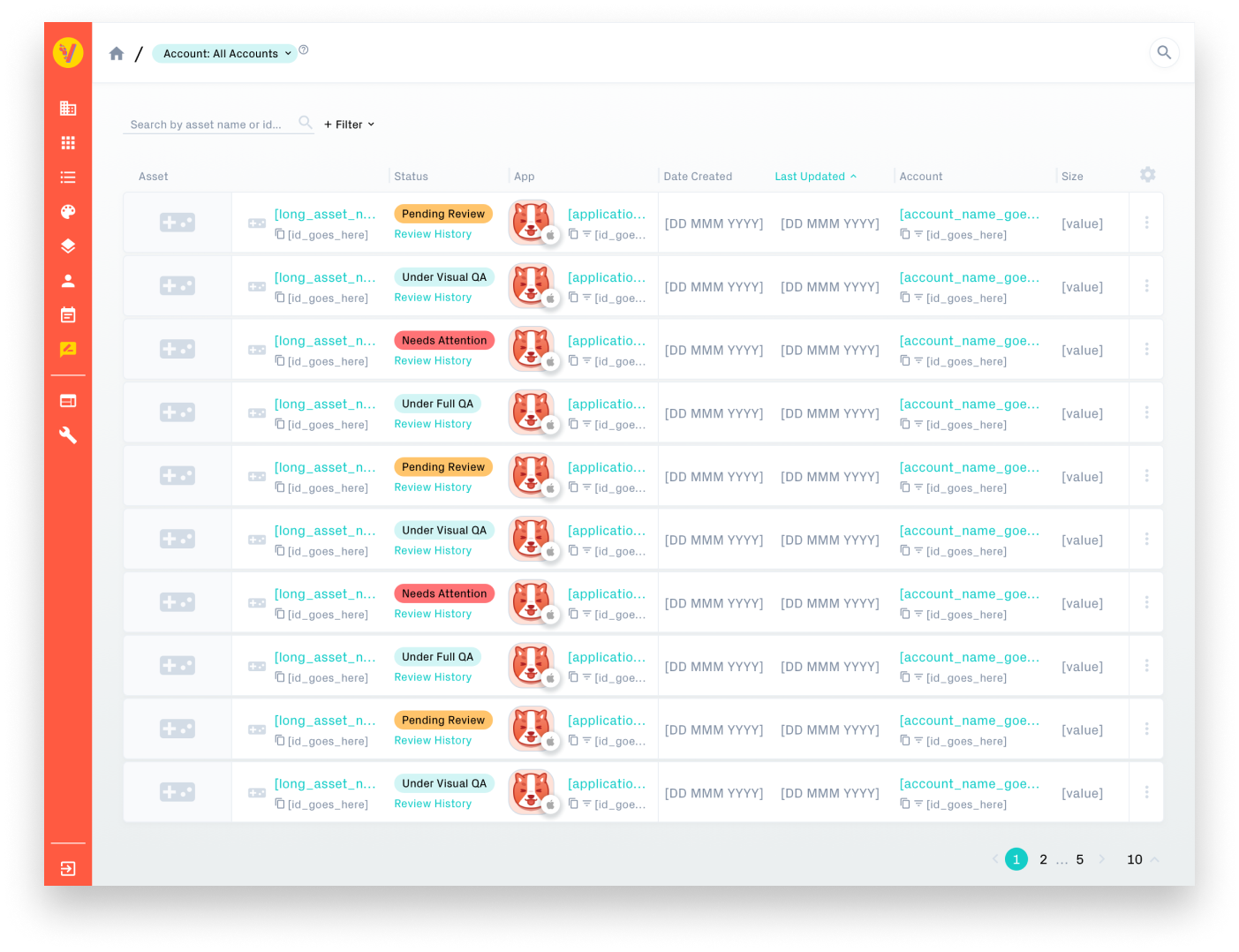
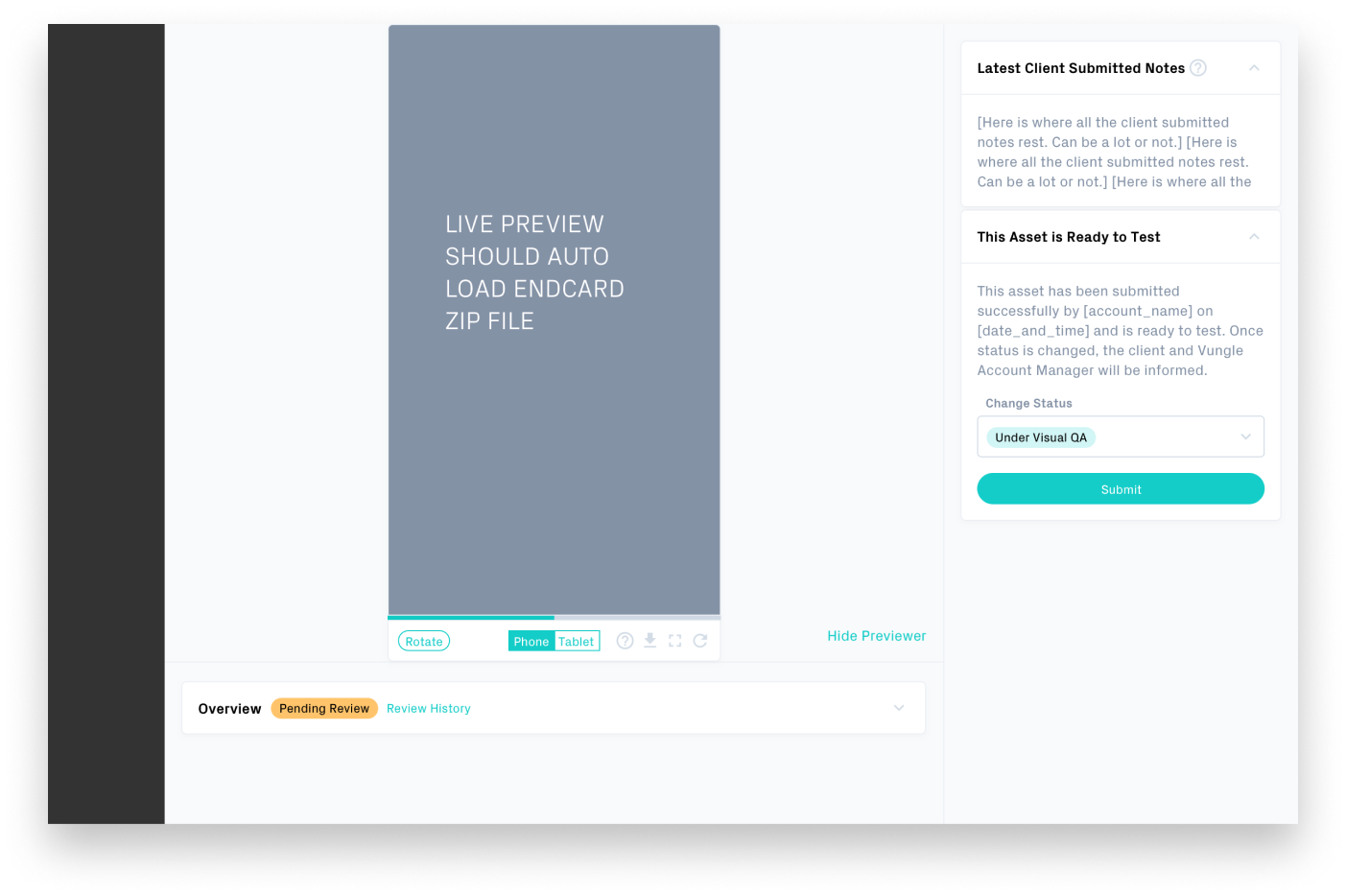
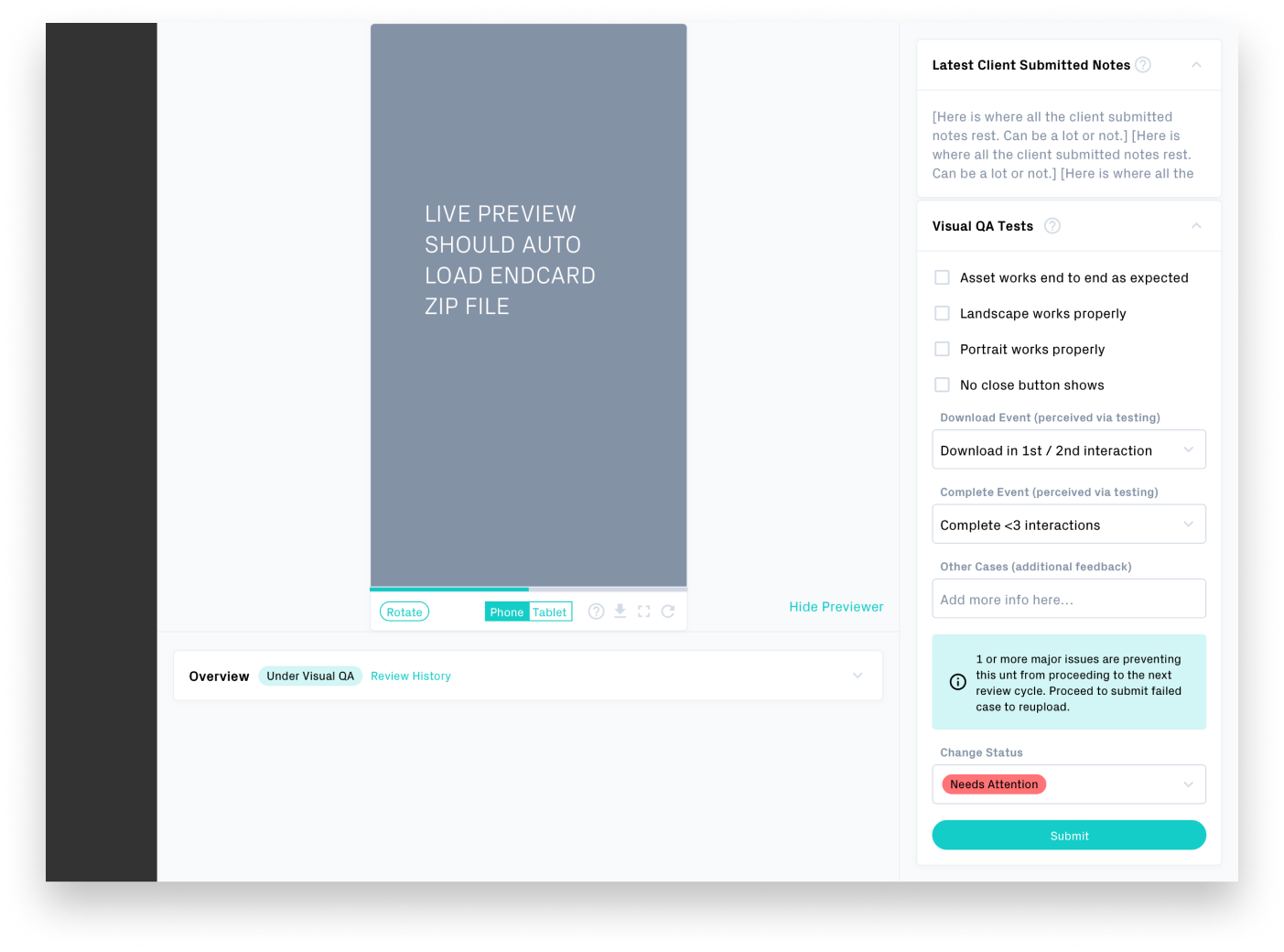
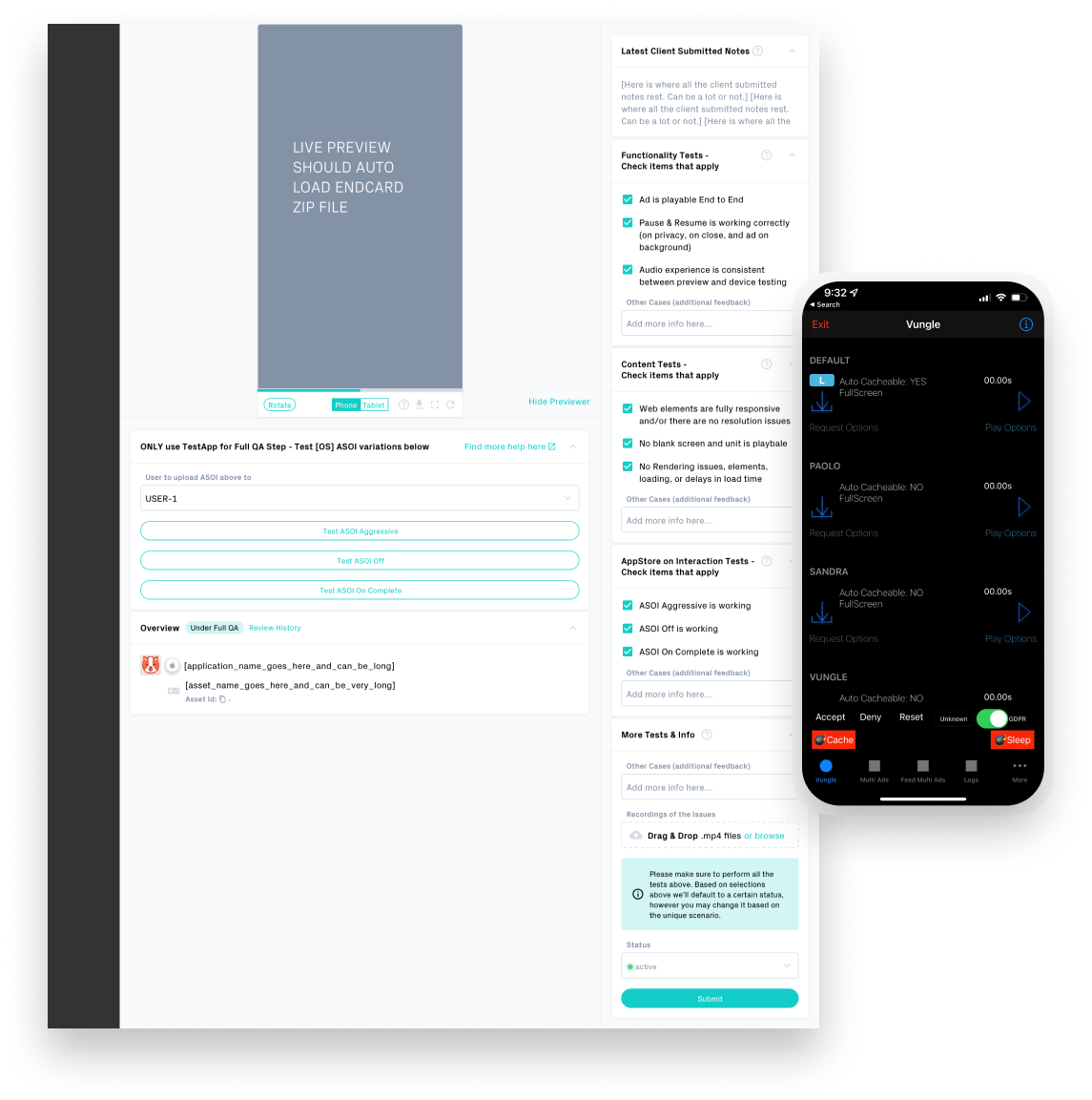
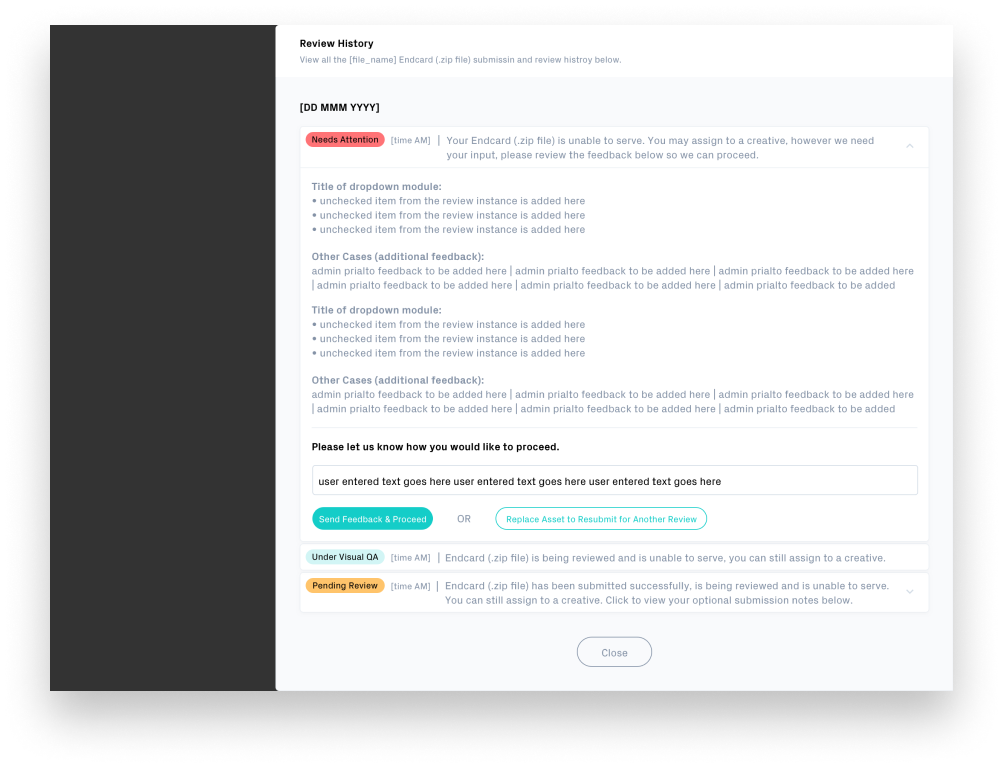
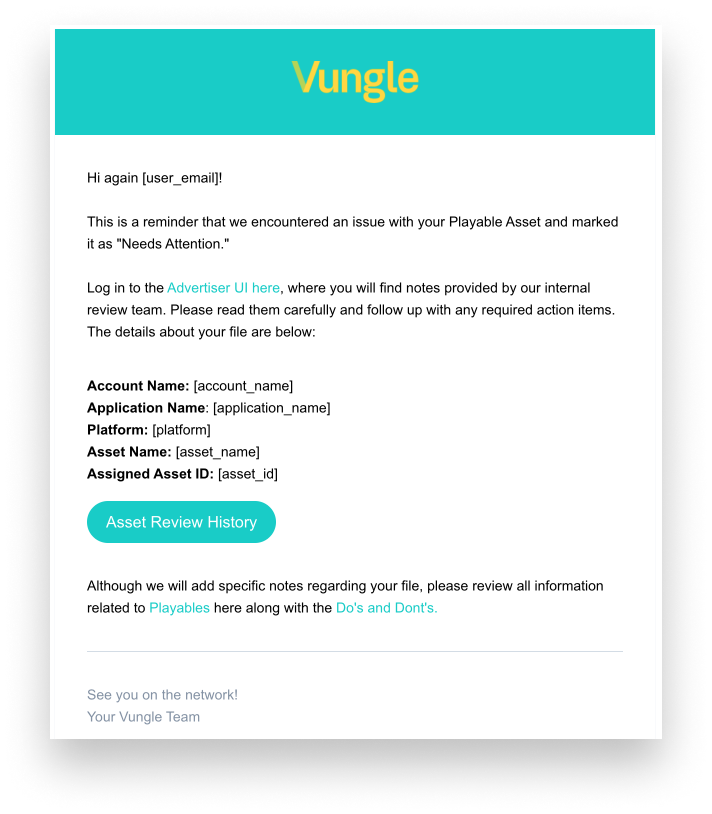
Key Outcomes
Client: User Acquisition Managers gained self-sufficiency, reducing dependence on Vungle Account Managers personnel.
Over 50 client accounts embraced the product upon its launch.
This innovation eliminated the prior manual process, allowing Sales to focus on business growth and new opportunities.
Other individuals responsible for content quality assurance experienced increased availability.
The new process achieved significantly quicker turnaround times, now taking only 2-3 days at most, compared to the previous 3-4 weeks.
Moving forward: what was next after the product release
While most of the intended process automation was achieved, the journey didn't conclude there. The ultimate goal was to eventually automate everything and completely remove human involvement.
Phase 1: The initial released product identified above.
Phase 2: Summarized below was intended to further refine the manual process and train the model to identify close button settings or other issues.
Phase 3: Full Automation - upload a file, our product would be to complete all the phase 1-2 steps in an efficient manner, identifying issues or success immediately.
Post-release, the focus shifted to the next set of goals:
Maintaining and monitoring the system for potential enhancements aligned with new user requirements.
Progressing towards increased automation to further shrink the 2-3 day review cycle to approximately less than 1 day.
Empowering clients to conduct testing on their own terms.
I used a combination of the software Fullstory, further user interviews via Google Hangouts, and the software called Dovetail.
Presented below is a functional prototype designed to replace the existing function. Unfortunately, I left Vungle before these Phase 2 modifications could be implemented, which had the potential to transform the 3-4 day review cycle into a matter of mere hours.
















